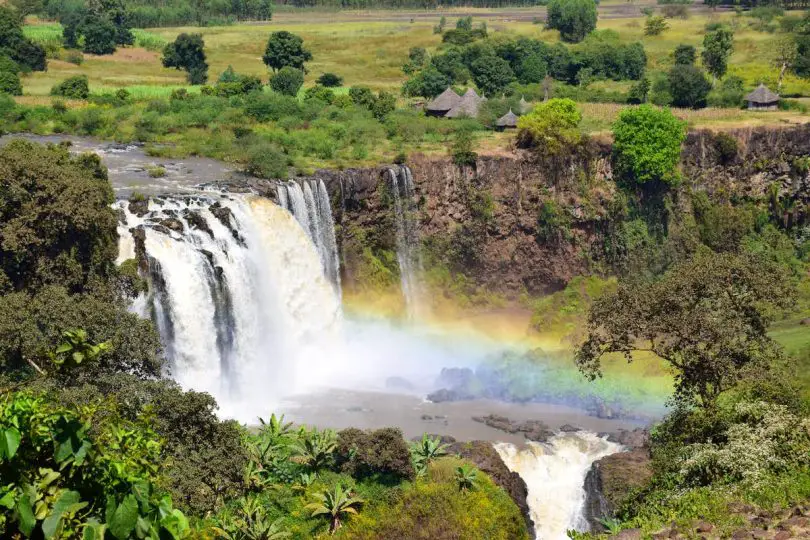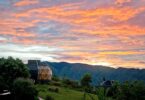Ethiopia, the “Land of Thirteen Months” is a magical country with ancient spiritual roots, and rich in religious history that has a story to tell. Ethiopia is the best and most incredible place to visit because it is where legends of the Ark of the Covenant live side by side in harmony with ancient Islamic mosques.
The beauty of wild mountains and the awe-inspiring religious architecture draw visitors to this amazing country. From thundering waterfalls to its vibrant and modern capital city, Addis Ababa, Ethiopia is a place you have to see to visit. Here are 11 of the best and most incredible places to visit in Ethiopia.
Table of Contents
Addis Ababa
Addis Ababa is the fourth largest city in Africa. This vibrant city is the diplomatic home to the African Union and sits atop the Entoto Mountains. Addis Ababa has a mystical aura that seems to act as a portal to the past.
Visit Merkato, Africa’s largest open-air market, and let the aromas of spicy spices and roasting coffee awaken your senses.

Addis Ababa. Photo/Council on Tall Buildings and Urban Habitat
Simien Mountains
Nestled in the highlands of northern Ethiopia is Simien Mountain. With its magnificent rock-hewn cathedrals and medieval castles, this Ethiopian gem takes you back in time.
Nature appears to have hand-shaped these gorgeous mountains, which are home to a rich cultural heritage. Witness the jagged peaks and seemingly endless landscapes while learning about ancient holy sites.
The Simien Mountains also host a unique but endangered ecology that includes unusual animals like the Walia Ibex, Ethiopian Wolf, Gelada Baboon, Klipspringer, and Bushbuck, as well as Klipspringer and Bushbuck.
Rock-Hewn Churches of Lalibela
There are eleven medieval churches near the small town of Lalibela, all carved out of large slabs of volcanic rock! These Churches were built on King Lalibela’s orders in the 12th century as a “New Jerusalem” for Christians who could not make the pilgrimage to the Holy Land because of Muslim conquests. It is now a popular pilgrimage place.
Lalibela is still very much a living cultural site, with 1,000 priests among its 10,000 citizens, and the churches serving as gathering places for celebrations, vigils, and processions.
The Holy City of Harar

Tourists feeding a hyena in Harar, Eastern Ethiopia [Photo by Don’t Stop Living]
Friendly Harari women dressed in colored outfits will meet you as you travel through the city’s cobblestoned and tiny alleys.
It won’t be long before the legend of Harar’s “hyena man” is told. The “hyena man of Harar” will call out to the hyenas by name near the Fallana Gate in Harari. The hyenas approach one by one, each taking a chunk of meat from a stick he has in his mouth. You can even hand-feed these wildly gorgeous but dangerous African predators if you have the courage.
Awash National Park
The Awash National Park is located along the Awash River in the middle of the rift valley, east of Addis Ababa. It is one of Ethiopia’s most beautiful wildlife reserves and is a reserve of arid and semi-arid woodland and savannah. Beisa Oryx gazelles, wild pigs, dik-dik, baboons, kudus, giant tortoise, hippos, aardvarks, hyrax, and Colobus monkeys are among the 46 species of animals found here. Along the river and in the woodland, there is a plethora of birdlife with over 392 bird species identified.
Gondar

Gondar Ethiopia. Photo/Africa Odyssey
Gondar is becoming a popular stopover for visitors going to Lake Tana and the Simien Mountains.
Gondar, the “Camelot of Africa,” can be seen from Ras Dashen, the highest point in the beautiful Simien Mountains. Churches, palaces, castles, a ceremonial bath, and a banqueting hall make up the Royal Enclosure, which is a cluster of spectacular buildings. Ethiopian Emperors and Princesses who ruled the kingdom for about 1000 years lived in the castle during the Middle Ages.
Fasiladas’ Bath
Fasiladas’ Bath, where the annual Timkat event takes place, is another must-see in Ethiopia. The bishop blesses the water, which is then poured on the crowd of pilgrims who come to renew their faith and take part in a ceremony that reenacts Christ’s baptism in the Jordan River. While you’re here, don’t miss Debre Berhan Selassie, which is widely regarded as one of Ethiopia’s most beautiful churches.
Blue Nile Falls

BlueNile Falls. Photo/Brilliant Ethiopia
The magnificent Blue Nile Falls are located in Bahir Dar. The most magnificent sight on the Blue and White Niles is ‘Tis- Isat Falls,’ which translates as “Smoke of Fire.” During the flood season, the falls extend a quarter-mile wide and descend into a valley over 150 feet deep. The locals named the falls from the never-ending mist that drenches sightseers from half a mile away. The rainbows created are breathtaking, as they create an Eden-like permanent rainforest of thick greenery. In this paradise, you will not be alone; the forest is home to a variety of monkeys and brightly colored birds.
Aksum
Aksum is one of Africa’s oldest cities, rich in history and mystery. It is thought to be the Queen of Sheba’s palace and the last resting place of the famous Ark of the Covenant. They do not permit visitors to enter the church where the Ark is believed to be, but the ancient Aksumite obelisks found in the Northern Stelae Field are worth seeing. After taking it during WWII, the Italian government recently returned the world’s largest obelisk to Ethiopia. Its ruins and stories will enthral any history lover.
Danakil Depression
The Depression is part of the enormous East African Rift Valley and borders Eritrea and Djibouti. It has a reputation for being one of the most hostile and yet most beautiful places on the planet. With explosive volcanoes, searing air temperatures, gasses, and land masses being ripped apart by massive planetary forces, temperatures can reach above 50°C.
The multi-coloured geothermal bubbling lakes and vast salt pans will make you wonder if you’re still on this planet. This natural phenomenon is both beautiful and dangerous, not for the faint-hearted!
The People of the Lower Omo Valley
If you want a cultural experience never to forget, then plan a trip to the Lower Omo Valley in Ethiopia and connect with one of more than a dozen indigenous peoples that live here.
Each of the villages has its customs and language and has lived the same lifestyle for centuries. The Mursi and Hamar are proud people who adorn themselves in unusual body art and jewelry and cattle are vital to their existence. They are also very territorial and will fiercely defend their land and way of life.








